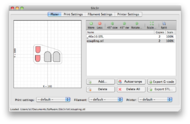Slic3r
|
English • العربية • български • català • čeština • Deutsch • Ελληνικά • español • فارسی • français • hrvatski • magyar • italiano • română • 日本語 • 한국어 • lietuvių • Nederlands • norsk • polski • português • русский • Türkçe • українська • 中文(中国大陆) • 中文(台灣) • עברית • azərbaycanca • |
Release status: working
| Description | STL-to-GCODE translator
|
| License | AGPLv3
|
| Author | |
| Contributors | |
| Based-on | [[]]
|
| Categories | |
| CAD Models | |
| External Link |
Slic3r is the tool you need to convert a digital 3D model into printing instructions for your 3D printer. It cuts the model into horizontal slices (layers), generates toolpaths to fill them and calculates the amount of material to be extruded. The project was started in 2011 from scratch: the code and the algorithms are not based on any other previous work. Readability and maintainability of the code are among the design goals.
Slic3r is bundled with the most important host software packages: MatterControl, Pronterface, Repetier-Host, ReplicatorG and has been supported/funded by almost all the main 3D printing companies in the world.
Availability
Slic3r is available in precompiled packages for MacOS X, Windows and Linux.
It's also possible to git clone and run Slic3r from there to stay current; a single script is provided to automatically install all dependencies via CPAN.
For more information check its Homepage (Download).
Support
Check its homepage support section for resources. Lulzbot (one of the companys supporting development) wrote a .pdf manual for Slic3r.
Tutorials, Documentation and Videos
The following page has links to Slic3r Tutorials, Documentation and Videos
Tech Details
The core of Slic3r is written C++ while Perl is used for "high-level flow abstraction, GUI and testing". Check out the source code over at GitHub.
Known Bugs
The actual Slic3r (at time of writing V1.3.0) has a known bug with the extrusion-settings under the option "advanced". It will not deliver optimal results if the parameters for standard are left at "0". To avoid the Bug, you will need to insert your actual nozzle-diameter or your desired extrusion width. To determine the bug, search for: a) Gaps between the parameters and the infill of each Layer b) far too little extrusion than expected at Infill (solid and normal)
